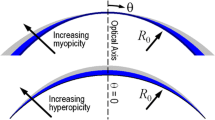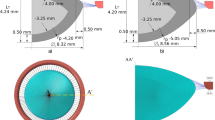Abstract
To characterize the materials parameters and deformation of a convex shell of axial symmetry, a hydrogel contact lens is mechanically deformed by two loading configurations: (a) compression between two parallel plates and (b) central load applied by a shaft with a spherical tip. A universal testing machine with nano-Newton and submicron resolutions is used to measure the applied force, F, as a function of vertical displacement of the plate/shaft, w 0, while a homemade laser aided topography system records the in-situ deformed shell profile and the contact radius or central dimple, a. A nonlinear shell theory and an iterative finite difference method are used to account for the large elastic deformation, the central buckling for the central load compression, and the interrelationship between the measureable quantities (F, w 0, a).





Similar content being viewed by others
References
Ashby MF (2005) Materials selection in mechanical design, 3rd edn. Butterworth-Heinemann, Woburn
Reissner E (1950) On axisymmetric deformations of thin shells of revolution. Proceedings of Symposia in Applied Mathematics, American Mathematics Society, Providence 3:27–52
Reissner E (1946) Stress and small displacements of shallow spherical shells. J Math Phys 25:80–85
Ashwell DG (1960) On the large deflection of a spherical shell with an inward point load. Proceedings of I.U.T.A.M. Symposium on the Theory of Thin Elastic Shells, Delft, August 1959, pp 43–63
Ranjan G, Steele C (1997) Large deflection of deep spherical shells under concentrated load. Proceedings. AIAA J/ASME 18th Structures. Structural Dynamics and Materials Conference. San Diego, California. Technical paper no 77-411 269–278.
Taber LA (1982) Large deflection of a fluid-filled spherical shell under a point load. J Appl Mech 49:121–128
Taber LA (1983) Compression of fluid-filled spherical shells by rigid indenters. J Appl Mech 50:717–722
Cagan J, Taber LA (1986) Large deflection stability of spherical shells with ring loads. J Appl Mech 53(4):897–901. doi:10.1115/1.3171878
Updike DP, Kalnins A (1970) Axisymmetric behavior of an elastic spherical shell compressed between rigid plates. J Appl Mech 37(3):635–640. doi:10.1115/1.3408592
Reissner E (1950) On axisymmetric deformations of thin shells of revolution. Proceedings of Symposia in Applied Mathematics 3:27–52
Essenburg F (1960) On a class of nonlinear axisymmetric plate problems. J Appl Mech 27:677–680
Updike D, Kalnins A (1972) Contact pressure between an elastic spherical shell and a rigid plate. J Appl Mech 39(4):1110–1114
Kalnins A, Lestingi JF (1967) On nonlinear analysis of elastic shells of revolution. J Appl Mech 89:59–64
Vaziri A (2009) Mechanics of highly deformed elastic shells. Thin-Walled Structures 47(6–7):692–700. doi:10.1016/j.tws.2008.11.009
Tranoudis I, Efron N (2004) Tensile properties of soft contact lens materials. Contact Lens & Anterior Eye 27:177–191
Osborn K, Veys J (2005) A new silicone hydrogel lens for contact lens-related dryness Material properties. Optician 229(6004):39–41
Johnson KL (1985) Contact mechanics. Cambridge University Press, Cambridge
Chen X, Dunn AC, Sawyer WG, Sarntinoranont M (2007) A biophasic model for micro-indentation of a hydrogel-based contact lens. J Biomech Eng 129(2):156–163. doi:10.1115/1.2472373
Lee SJ, Bourne GR, Chen X, Sawyer WG, Sarntinoranont M (2008) Mechanical characterization of contact lenses by microindentation: Constant velocity and relaxation testing. Acta Biomater 4(5):1560–1568. doi:10.1016/j.actbio.2008.02.021
Mow V, Lai W, Hou J (1990) A triphasic theory for the swelling properties of hydrated charged soft biological tissues. Appl Mech Rev 43:S134–141
Seide P (1975) Small elastic deformations of thin shells. Noordhoff, Leyden
Flugge W (1973) Stresses in shells. Springer, New York
Calladine C (1983) Theory of shell structures. Cambridge University Press, Cambridge
Landau LD, Pitaevskii LP, Lifshitz EM, Kosevich AM (1986) Theory of elasticity, 3rd edn. Butterworth-Heinemann, Oxford
Timoshenko SP, Gere JM (2009) Theory of elastic stability. Dover, New York
Taber LA (2001) Biomechanics of cardiovascular development. Annu Rev Biomed Eng 3:1–25
Aktas Z, Stetter H (1977) A classification and survey of numerical methods for boundary value problems in ordinary differential equations. Int J Numer Meth Eng 11:771–796
Acknowledgements
This work is partially supported by Johnson & Johnson Vision Care, Inc. We are grateful to Drs. John Enns and Annabelle Gallois at J&J for invaluable discussions and technical support. This work was also partially sponsored by the National Science Foundation through Grant CMMI # 0757140. Any opinions, findings, and conclusions or recommendations expressed in this material are those of the authors and do not necessarily reflect the views of NSF. We also thank Professor Andrew Gouldstone and Dr. Maricris Silva of Northeastern University for her assistance in measuring the thickness of the contact lenses using optical coherence tomography (OCT).
Author information
Authors and Affiliations
Corresponding author
Appendix
Appendix
Nomenclature
- ϕ0 :
-
angle between the outer normal of shell element and symmetry axis of non-deformed shell
- ϕ:
-
angle between the outer normal of shell element and symmetry axis of deformed shell
- \( \phi^{*}_{0} \) :
-
denotes value of ϕ0 at the contact edge
- \( \phi^{\dag}_{0} \) :
-
denotes value of ϕ0 at the base of the shell
- β:
-
rotation of normal
- r 0 :
-
distance from symmetry axis before deformation
- R :
-
radius of undeformed shell
- c :
-
radius of the base of the shell
- E :
-
Young’s modulus
- v :
-
Poisson’s ratio
- t :
-
thickness of shell
- K :
-
Et / (1- v 2)
- D :
-
Et 3/ 12(1- v 2)
- F :
-
total load on shell
- \( {{\text{e}}_\phi },{{\text{e}}_\theta } \) :
-
meridional and circumferential strain
- \( {{\text{k}}_\phi },{{\text{k}}_\theta } \) :
-
meridional and circumferential bending curvature
- w, u :
-
deflection parallel and perpendicular to axis of symmetry
- V, H :
-
stress resultants parallel and perpendicular to axis of symmetry
- p V , p H :
-
surface loads parallel and perpendicular to axis of symmetry
- \( {N_\phi },{N_\theta } \) :
-
meridional and circumferential stress resultants
- \( {M_\phi },{M_\theta } \) :
-
meridional and circumferential moment resultant
- Q :
-
transverse shear resultants
Numerical Method
Finite difference method is employed here to solve this boundary boundary-value problem governed by a system of first order ordinary differential equations (ODE) [27]. A two point boundary value problem in the interval I = [c 1, c 2] can be defined by a system of first-order ODEs and boundary conditions as follows.
The interval I is divided into M segments uniformly and the choice of M should be a sufficiently large number to guarantee the accuracy of the solution. I m = [c m-1, c m ] denotes one specific segment where m = 1…M. For the shell problem described by equations (1-5), the boundary-value problem is stated in terms of the six unknowns, y = {w u β V H M ϕ}. Equations (1-5) are rearranged in the form in equation (17) as follows.
Using the (implicit) trapezoidal rule, the residual vector \( {\psi_m} \) for a segment I m is defined as follows.
where ϕ m represents the terms on the right hand side of equation (18). Considering the finite difference segmentation of the entire shell one would get (M + 1) vector equations for the (M + 1) vectors y 0, y 1, …, y M each having 6 unknowns. For the solution of the large system of non-linear equations (19), Newton’s method is employed. A multivariable Taylor series expansion of the residual form of equation (19) is used to linearize the system. When all of the segments are considered the system of equations is expressed in the following form.
where the superscript i indicates solution iteration level, and {∆y}(i+1) is the correction to the dof vector between the iterations. The Jacobian matrix D ψ y is defined as
To calculate Jacobian matrix (21), equation (18) is differentiated with respect to each of the unknown variables, i.e. {w u β V H M ϕ}T. The prime below denotes derivative respect to any one of the six variables. Thus,
where
The solution algorithm is shown in Fig. 6, a constant relaxation coefficient C, with a value between 0 and 1, is employed in some cases to help converge.
Rights and permissions
About this article
Cite this article
Shi, J., Robitaille, M., Muftu, S. et al. Deformation of a Convex Hydrogel Shell by Parallel Plate and Central Compression. Exp Mech 52, 539–549 (2012). https://doi.org/10.1007/s11340-011-9514-z
Received:
Accepted:
Published:
Issue Date:
DOI: https://doi.org/10.1007/s11340-011-9514-z





